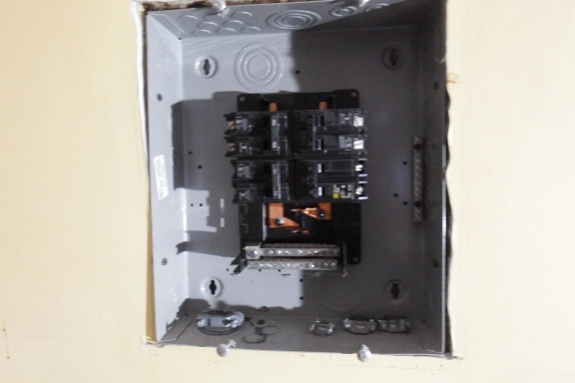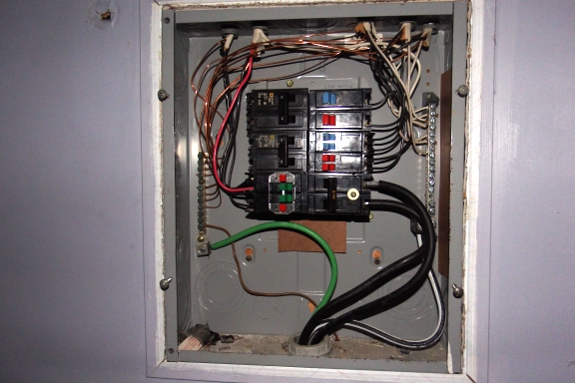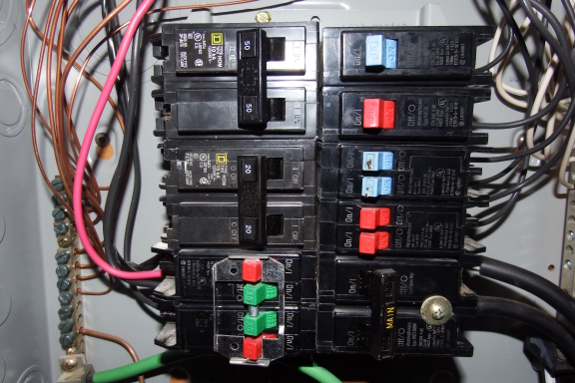
What can we fit in our electric box?

Our trailer came with
some interesting wiring puzzles. First was this empty breaker box in
the living room with absolutely nothing attached to it. Our best guess
is that this was originally wired to an electric stove and furnace
(both of which are absent, including their cords). Since the main
breaker box (like this one) is only wired for 100 amp service,
presumably the previous owners ran a second line in the trailer's
original location and made the trailer 200 amps in a complicated way.

So, the question became
--- can we wire the new items we'll need into the main breaker box or
do we need to follow the previous owners' lead? The first step was
taking a good hard look at the breakers currently in use. On the right
side, from top to bottom, there's a 15 amp breaker, a 20 amp breaker, a
15 amp breaker, a 20 amp breaker, then the main line coming in.
Excepting the last, this side is clearly wired to the sockets in the
walls throughout the house (based on the small amperages and the
similarly small wires).
On the left side, only
the bottom breaker(s) are in use. I say "breaker(s)" because this
appears to be a 20 amp breaker with a 30 amp breaker in the middle, and
I'm assuming the two are attached to the now absent dryer and hot water
heater (respectively). Above that are two unused breakers.
What do we want to put
back in? An electric range (40 or 50 amp breaker), a heat-pump water
heater (30 amp breaker), a gas dryer (15 amp breaker...and a long story
we'll tell you in another post), and a minisplit heat pump (15 amp
breaker). Technically, these will all fit into the box, but will we be
going over the amount of juice a 100-amp service can supply?

The internet suggests
the rule of thumb is that the total amperage in your breaker box
shouldn't exceed twice the total amperage of your service. So, a
100-amp breaker box can be wired with 200 amps worth of breakers.
Adding up everything we have and want comes to 180 amps. So, unless I'm
missing something, it looks like we're all set to wire in our new
appliances!
(Sorry for the sparse,
shoddy photos. It's a dark day and no electricity means we can't
brighten it up much. We're hoping for juice by the end of the week!)
Want more in-depth information? Browse through our books.
Or explore more posts by date or by subject.
About us: Anna Hess and Mark Hamilton spent over a decade living self-sufficiently in the mountains of Virginia before moving north to start over from scratch in the foothills of Ohio. They've experimented with permaculture, no-till gardening, trailersteading, home-based microbusinesses and much more, writing about their adventures in both blogs and books.
Want to be notified when new comments are posted on this page? Click on the RSS button after you add a comment to subscribe to the comment feed, or simply check the box beside "email replies to me" while writing your comment.

Hi Anna and Mark,
Electricity is simple. My first house had 60 amp. So I added a second panel with lots of breakers for electric heat, dryer, etc.
But for you maybe getting it turned on somehow would appear to be the real problem. I didn't have that problem.
i.e.- Large panel, few breakers. Then just add them and make it look more or less right.
You can always pay a 'real' electrician to come and bless what you have done.
One caution. Connections especially for large conductors may need to be retightened after a year or so since they 'relax' when under pressure.
Good luck. And get someone to show you how to be safe as you play. Left hand in back pocket, Put insulating tape on your tools if working near live wires. Always assume wires are live, etc.
John